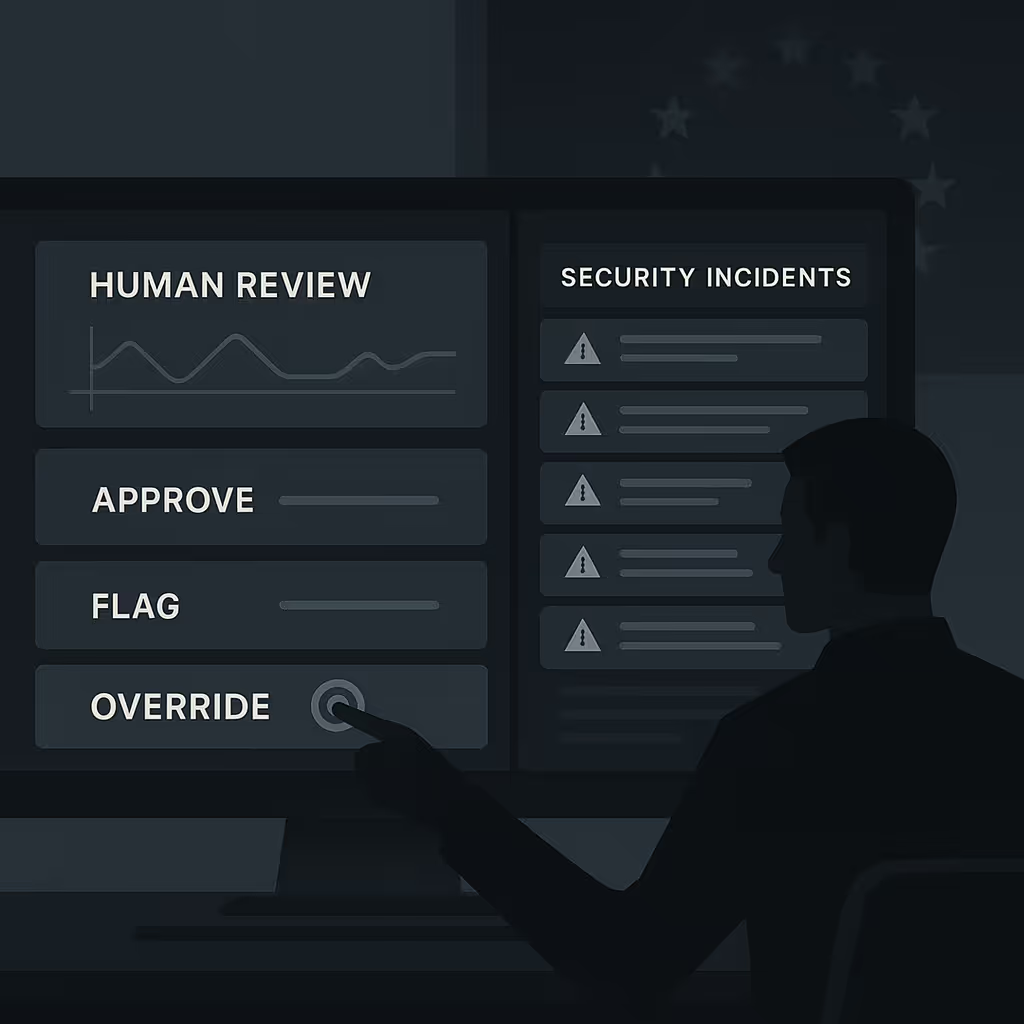EU AI Act
Risk & Governance
Readiness for the EU’s risk-based framework for AI systems: risk-tier classification, role mapping, conformity route, technical file, testing, human oversight, and post-market monitoring sized to product scope and launch timeline.
Who This Applies To
Applies to organizations that build, supply, or use AI systems in the EU — including non-EU companies serving EU users. Covers providers, deployers, importers, and distributors, with a focus on higher-risk use cases; expect role clarity, risk classification, a technical file, conformity steps, and ongoing monitoring.
What benefits of AI Act for business:
Market access & procurement
Risk and liability control
Trust and revenue enablement
Operational discipline at scale

Quick Start Overview

AI Act
Roadmap
Phased path to readiness, risk-tier classification, role mapping, conformity route, technical file index, testing plan, human-oversight controls, and post-market monitoring.

AI Act Readiness
Pricing
Scope-based tiers for startups and scale-ups: pricing linked to system risk, number of use cases, and evidence depth, includes artifacts list and an estimated effort/timeline.

EU Market Entry for Non-EU Companies
Operational pathway for non-EU providers and deployers — representation option, importer/distributor handoffs, documentation and labeling flows.
AI Act Process Roadmap
Risk Tiering & Confomity Route
Classify the system, choose the conformity path, confirm notified-body needs, and set a prioritized milestone plan.
Technical Documentation, Data & Model Validation
Compile the technical file and generate traceable evidence from bias/robustness/accuracy testing.
Human Oversight and Security
Oversight transparency with logging, access, security, incident response, and change control.
Post-Market Monitoring
Set up feedback, drift and event logging, periodic reviews, retrainers, and compliance reports.
1. Risk Tiering & Confomity Route
Determine the system’s risk class, map roles and duties, select the conformity path and applicable standards, identify notified body, and generate a prioritized gap list with milestones.
Risk Tier Classification
Classifying each use case against the EU risk using intended purpose, context of use, affected users, and autonomy.
Conformity Route & Notified Body Needs
Pick the conformity route, align to harmonized standards, verify QMS readiness, and flag notified-body needs.

2. Technical Documentation, Data & Model Validation
Core evidence set — technical file (purpose, architecture, risks, controls) and data governance (provenance, quality, bias) with traceability, test reports, and auditable records aligned to harmonized standards for procurement, NB review, and releases.
Technical Documentation
Purpose, architecture, risk summary, control mapping, and a traceability index linking requirements to tests and evidence.
Data Governance and Records
Provenance and lineage, quality and bias checks, retention/access rules, and auditable records across training, tuning, and deployment.
Model Testing and Robustness
Planned tests with accuracy, bias, and robustness metrics, and release gates with documented thresholds.
3. Human Oversight and Security
Safeguards for understandable, controllable AI, human-in/over-the-loop checks, clear disclosures, full logging & access control, secure dev/runtime, monitoring, and incident response with reporting.
Human Oversight & Transparency
Design clear decision checkpoints and escalations, log rationale, and enable traceable review of high-impact outputs.
Cybersecurity & Incident Handling
Access management, continuous logging, incident playbooks for containment, evidence for notification and post-incident review.

4. Post-Market Monitoring
Keep the system on track: collect feedback and incident reports, run regular reviews, control retraining, and keep clear records.
Feedback & Incident Intake
Centralized channels for user feedback and incident reports with triage rules, severity levels, user notices, and linkage to logs and evidence.
Performance and Drift Monitoring
Use-case metrics and bias monitors with thresholds, alerts, and shadow checks to detect accuracy loss, misuse, or context change.
Periodic Review
Scheduled reviews, root-cause analysis, correctiv actions, retraining and change control, plus regulator/client reporting and retention of records.

AI Act
Packages & Pricing
Starter 30-Day
Startup Pre-seed / Series A or Small company
Launch 90-Day
Scaling startups or Small / Medium company
Continuous Shield
Live in EU / going live this quarter or Recurring releases
EU Market Entry for
Non-EU Companies
Pathway for non-EU providers and deployers to enter the EU market: role mapping, EU representation option, importer/distributor handoffs, conformity route with technical file and labeling, post-market reporting lines.

Start AI Act Regulatory Readiness
Get a scoped 30/60-day plan with required artifacts and milestones.
FAQs
Discover answers to your pressing questions about AI Act compliance services and requirements.
A risk-based rulebook for how AI is built and run in the EU. Teams classify use cases, map roles, choose a conformity path, prepare a technical file (purpose, data, tests, oversight, security), and monitor after launch with logs, incidents, and periodic reviews.
Most focused products reach initial readiness in 2–3 months. That covers scoping, risk tiering, conformity route, a technical file foundation, core testing evidence, and a basic post-market plan. Broader portfolios or multiple high-risk use cases take longer.
Now. Readiness work stacks up fast — data mapping, test design, evidence generation, and process updates. Leaving it until late compresses tasks, raises cost and delivery risk, and can block enterprise deals or market entry.
Late starts often lead to incomplete technical files, rushed testing, limited availability for external reviews, and slower procurement cycles, making it hard to “do everything in a day.” Starting early spreads effort, reduces rework, and keeps launch or sales timelines on track.
Yes. If EU users can access or use the system, the rules apply. Non-EU firms may need an EU representative and must meet the same documentation, testing, transparency, and monitoring duties.
Think impact and context. High-risk often means: consequential decisions, vulnerable users, autonomous operation, bias potential, or fundamental-rights impact. If several apply, treat it as high-risk until assessed.
It depends on the chosen route. Many high-risk systems can use internal control when aligned to standards and backed by a QMS. Third-party review is needed when standards aren’t used, when tied to other product laws, or when the route requires it.
Before: classify risk and roles, pick the route, build the technical file (data governance, testing, oversight, security), set instructions.
After: track KPIs and drift, handle incidents and feedback, run CAPA and controlled retraining, keep evidence up to date.
